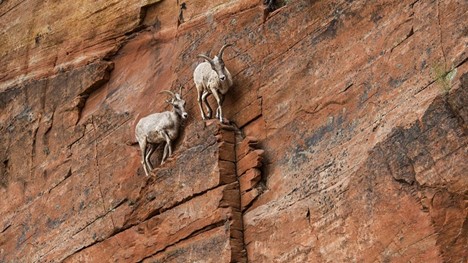The Aoudad or Barbary Sheep: Majestic Explorers of the Desert
Welcome to our blog post about the fascinating Aoudad or Barbary Sheep! These magnificent creatures are known for their unique characteristics and captivating beauty, making them a truly special species to explore. In this article, we will dive into the origin, habitat, behavior, and cultural significance of the Aoudad or Barbary Sheep, providing you with interesting insights into their world.
Origin, Habitat, and Range
The Aoudad or Barbary Sheep, scientifically known as Ammotragus lervia, originates from the mountainous regions of North Africa, including the Atlas Mountains of Morocco and the Sahara Desert. They have adapted to survive in harsh desert climates by occupying rugged rocky terrains, making them fantastic climbers. Their natural habitat allows them to seek shelter in caves, crevices, and other areas that protect them from extreme temperature conditions.
Physical Characteristics
Aoudad or Barbary Sheep are sturdy animals with a striking appearance. They have a compact, muscular build, with males weighing an average of 220-300 pounds and females being slightly smaller. One of their most notable features is their impressive spiraled horns, which can measure up to 30 inches in length. Their dense coat varies in color, ranging from sandy brown to reddish-brown, providing excellent camouflage in desert environments.
These remarkable creatures are well-adapted to the arid landscapes they inhabit. Aoudad or Barbary Sheep are herbivorous animals, mainly consuming grasses, shrubs, and cacti. Their digestive system is highly efficient, allowing them to extract maximum nutrients from sparse vegetation. They are also highly agile climbers, using their sharp hooves and incredible balance to navigate steep cliffs and rocky terrain effortlessly.
According to the Encyclopedia of animals, Aoudads “stand 110 cm (2.46 to 3.61 ft) tall at the shoulder, with a length about 1.5 m (4 ft 11 in), and weigh 30 to 145 kg (66 to 320 lb) [1]. They are sandy-brown, darkening with age, with a slightly lighter underbelly and a darker line along the back. Some shaggy hair is on the throat (extending down to the chest in males) with a sparse mane. Their horns have a triangular cross-section. The horns curve outward, backward, then inward, and can exceed 76 cm (30 in) in length.” The horns are fairly smooth, with slight wrinkles at the base as the animal matures. If you have land with Aoudads on the property, be careful of your feeders. Aoudads will battle the triangle-shaped feeders to get the corn.
Behavior and Adaptations
In terms of social structure, Aoudad or Barbary Sheep live in herds consisting of both males, females, and their offspring. Within the herd, there is a hierarchy established through dominant behaviors and confrontations between males. During the mating season, known as the rut, males use their impressive horns to compete for dominance and access to females. This period is a fantastic spectacle, with fierce battles occurring between males to establish dominance and breeding rights.
Cultural and Historical Significance
The Aoudad or Barbary Sheep have held a significant place in the cultural and historical narratives of the regions they inhabit. In Berber folklore and traditions, these majestic sheep are seen as symbols of strength, resilience, and endurance. They are often associated with traits such as bravery and honor. Furthermore, historically, the Barbary Sheep were hunted for their meat and hides, and their horns were used as symbols of status and power.
Aoudad or Barbary Sheep in the United States
If you watch the James Bigley ranches videos, a Texas Realtor, on TikTok, you will see information on western acreage for sale and will have seen stories about exotics living in Texas. Featured stories have included feral pigs and wild Axis deer. Today we want to visit Barbary Sheep, also called Aoudad (awdads), a caprinae or goat-antelope. An example in the west is a curved-horn mountain goat, seen standing on steep terrain in the Rocky Mountains.

The releases of Aoudads were intended to increase big-game hunting. Soon they competed with Big Horned Sheep. In Texas they were introduced in the 1940s and now threaten the population of Big Horned Sheep. Aoudads are hardier, breed rapidly, and run in packs.
The Ecological Threat
Barbary sheep are a threat to mule deer and bighorn sheep because of direct competition for food and habitat resources. Mule deer and Barbary sheep feed on similar vegetation and mule deer risk being outcompeted by the aggressive invasive Barbary sheep. Efforts to reintroduce big horn sheep populations are at risk because of habitat competition. Barbary sheep can be aggressive and territorial, with the ability to climb and evade predators successfully. They also live in packs comprised of mature and immature members allowing a pack size advantage over the native bighorn sheep. Barbary sheep are a threat to wheat farmers, with several observations of the invasive sheep feeding on winter wheat crops. They are not currently considered significant agriculture pests.
Can You Eat the Meat?
Aoudad sheep are a type of wild goat that is found in the dry parts of Texas. The meat from these animals is tough and lean, but it can be quite flavorful if properly prepared. When slow-cooked, the meat becomes tender and delicious.
Aoudad Hunting Information
Aoudad or Barbary Sheep United States Range - Interactive Mapping
Range of Aoudad in the US and in each state is updated through crowd sourcing on social media. Community members comment on where they have seen low fence Aoudad across the United States. Mapping is updated accordingly.
Aoudad (Barbary Sheep) Texas Range



